
|
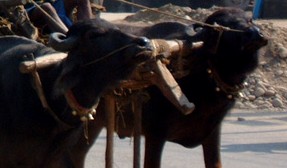
Photo by Alastair Seaman |
| Text and Context in Dialogue |

|

Photo by Alastair Seaman |
| Text and Context in Dialogue |
Lifting the yoke: Why the bhakta of Christ should take tika
by
Dasain has always been an occasion of great turmoil for the followers of Christ in Nepal. Though they have wanted to honour their relatives the question of the taking of tika and prasad has resulted in many breaking all contact with them. This conflict is all the more tragic as it has often not been necessary. I believe that Christ's disciples should be free to join in the festival of Dasain. But before I back up that assertion I must first describe the festival and discuss its meaning.
The waxing lunar fortnight of September/October is the occasion for the celebration of Nepal's most important festival - Dasain.[1] The festival of Dasain is essentially focused around the lineage or clan.[2] Close patrilineal relatives are defined partially by their celebration of this event together, i.e. "if you celebrate Dasain with us you are one of us". In parallel with other lineages, the royal lineage also celebrates Dasain. Ordinary citizens do largely the same rituals as the king, though, as one would expect, on a humbler scale.
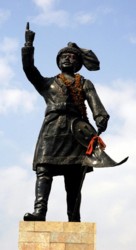
Photo by Tim Frank |
The ritual of Dasain revolves around the establishing and worship of a Flask (kalash) as Durga.[3] The ritual is most elaborate in the old palaces of the former Malla kings in the cities of the Kathmandu Valley. Essentially the same ritual on a humbler scale is repeated throughout the kingdom in army barracks, police posts and residences. On the first day of the lunar fortnight (Np. Ghatasthapana), a mixture of maize and barley seeds are sown in a seedbed in the puja room of the house and a Flask is established as Durga. This is the focus of worship throughout the ten days. The seedbed is covered and the shoots grow up in the dark, making them pale. On the seventh day the festival really takes off with household purification rituals and the moving of the images of Taleju from their normal temples to a special temple in each of the old palaces of Kathmandu, Lalitpur and Bhaktapur. Sacrifices accompany every element from this point until the tenth day. On this day also a Flask and phulpati (a palanquin filled with flowers) arrives at each of the palaces of the former Mallas from Nuwakot, the place from which Prithvi Narayan Shah planned his conquest of the Valley.[4] The arrival of the procession to Kathmandu is elaborately celebrated with military bands and a gun salute in the presence of the king and government ministers. |
|
The next day many buffaloes and goats are sacrificed in the courtyards of the old palaces. That evening, at least in Newar households, the first of three feasts is consumed. The Kalaratri (Black Night) follows, in which hundreds of buffaloes, goats, sheep, and ducks are sacrificed at Mother Goddess temples in the old palaces and throughout the kingdom. The next day is even more important for sacrifices. Most Newar homes offer sacrifices of goat and duck to Durga.[5] In order to distinguish between sacrifice and murder the victim must give his assent to his death, which he does by shaking his head or (in the case of the goat) his entire body. Water is sprinkled over the animal and into the ear, which usually has the desired effect. Newars slaughter the animal by slitting the throat to allow blood to flow on to the image.[6] Parbatiyas (Hill Brahmans and Chetris) simply lop off the head with a quick downward chop of the khukuri (curved Nepalese knife). Sacrifice is also made to Durga to request her protection on motorbikes and cars for the coming year. Blood is directed onto the wheels and bumpers of the vehicles along with spirits, flowers, rice and vermilion. Those who want to participate but do not want to take life offer as alternatives duck or chicken eggs. Puja is also offered to household tools. More feasting follows. |
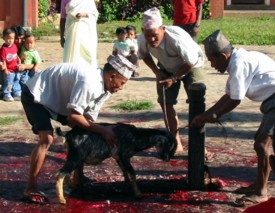
Photo by Rosalind Henwood |
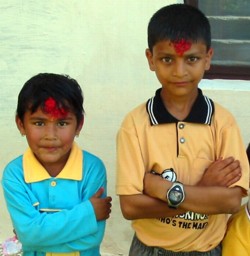
Photo by Rosalind Henwood |
On the tenth, and greatest day of the feast (Vijaya Dasami), the barley and maize shoots (Np. jamara) are brought out from the puja room where they have been worshipped each morning. Everyone is in festive spirits. In the Newar community the lineage gathers at the house of the senior male (thakali) to participate in the main ceremony - the ritual of the cutting of the pumpkin. In preparation for this a Citrakar Painter comes to the house and paints the face of the demon Mahishasura on a large, unripe pumpkin. Then, when all are gathered, and everyone has had a chance to do puja to the pumpkin, it is 'sacrificed' by a male member of the lineage by striking it with a sword.[7] The thakali takes the offered flowers and presents some to each member in order of seniority, along with tika (the red mark applied on the forehead), fruit, seedlings (representing Durga's sword), and red and white strips of cloth, as prasad (i.e. the blessing of the deity in return for worship). Each member then receives tika from each other member senior to himself and, in turn, gives it to each of his juniors. This prasad is exclusively for the lineage. Married-out daughters and their families are not allowed to partake, as they do not belong. The remaining days of the fortnight are relaxed and pleasant days for visiting and feasting at the homes of relatives. Married-out daughters and their families visit their natal homes, and all visit the home of their mother's brother, to receive prasad in the form of tika, fruit, and seedlings and to enjoy a feast together. |
The Dasain festival is clearly tied to the agricultural cycle with the symbolism of the barley and maize shoots. Indeed the festival heralds the beginning of the rice harvest. The festival is essentially focussed on the lineage; other relatives, such as one's married-out daughters may not see the shoots. They will visit only after the puja is complete.
The Karttik dance-dramas (Nw. Kati Pyakhan, Np. Karttik Nach) have been acted out on the dance platform opposite the old Lalitpur palace (Patan Durbar) almost uninterrupted since the seventeenth century and give us an insight into the meaning of Dasain. The dance-dramas attract great crowds of onlookers each evening for eight nights around the eleventh night of the lunar fortnight (Haribodhini Ekadasi) on which, according to myth Vishnu awakens from his four-month long sleep (corresponding to the ancient monsoon season). The programme of the dance-drama is structured around this pivotal moment.
|
The 'Goddess Dance' ('Devi Pyakhan') is always performed on the evening immediately preceding Vishnu's awakening. It is a very entertaining drama beginning with a slapstick comedy by vulgar Untouchable Fishermen (played by Maharjan Farmers). The two inebriated men, ridiculously dressed, swagger around the stage, flinging fishing nets out to catch cloth fish that are teasingly cast towards them by the audience. They make lewd gestures and shout vulgarities at each other in a manner that would normally be considered offensive. The Fisherman dance is followed by that of the Kanwan, the skeletal demon who strikes fear into the heart of stouthearted men. He rushes about the stage, making ribald gestures and shouting obscenities at the audience who find it all very comical. After the Kanwan comes the Khya, the goblin with the lolling red tongue. He dances by standing on his head. The message of the dance-drama is clear: things are awry, the world is in chaos. Untouchable Fishermen are unrestrained. Demons wreak havoc in the city. Then the Devi dance begins. The dangerous goddesses Kumari and Mahalakshmi (manifestations of Devi - the Goddess) enter the stage with their equally terrifying male counterpart Bhairava. With energetic rushes and dynamic twirls, lunging jabs and trenchant swipes of the sword they rid the earth of evil and restore the world to its proper order. |
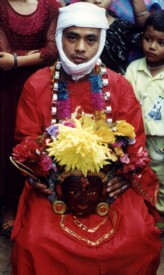
|
The festival of Dasain falls within the period of Vishnu's sleep. During this period, as Vishnu is not available to aid his troubled devotees, the evil that threatens the world order must be vanquished by the Goddess. The focus of the Dasain ritual, then, is the Goddess. It is she who receives the puja in her various manifestations. It is she, also, in her manifestation as Durga, who defeated the demon Mahishasura. In the popular mind then, the Goddess is the one who has put evil to flight in the months following rice planting. Chaos has threatened the social order. It is this festival that restores the order within the lineage. During Dasain that order is re-established by the sharing of the feast and the giving and receiving of tika.
The celebration of Dasain in Nepal has parallels throughout the Hindu world, often being described as the festival of kings and kshatriyas (chiefs, warriors).[8] The demon king Mahishasura represents the forces of ignorance and chaos. Mahishasura's reign began when he overthrew the gods and forced them to live on the earth oppressed by the demons. "Durga's victory enables the gods to regain their kingdom and so to restore the universal dharma predicated on rule by a rightful king."[9]
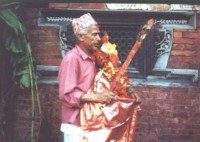
|
Dasain, then, is a royal festival. In the old palaces, the king's sword, the ultimate symbol of his sovereignty, is brought down and placed in divine custody in the Goddess's Dasain room, for the duration of the high period of the festival. The king needs the sword for battle and it will be returned to him for that purpose once the puja is complete.[10] There is, then, a message in this symbolism: the king and the Goddess are "allies wielding the same weapon in the same cosmic war".[11] Furthermore, the worship of tools and vehicles on the ninth day harks back to another royal and kshatriya ritual - the worship of elephants and horses as well as weapons of war. The weapons are imbued with divine power for the coming campaigning season - a ritual that has, in Nepal perhaps, once again taken on a heightened significance since the escalation of the Maoist insurgency. |
Sacrifice plays a central role in the ritual of Dasain. The king is the patron of the sacrifice - the buffalo must be seen as a substitute for both him and his subjects. But as each buffalo sacrifice re-enacts the slaying of the demon, the king is also identified with the victorious Goddess. Through the sacrifice the king (and on a smaller scale each householder) subjugates his enemies. So it is easy to see why the present dynasty has promoted the national character of Dasain throughout the realm. The festival, as Fuller rightly judges, is "a ritual of legitimation".[12]
How deeply does such symbolism affect the country's citizens as they celebrate the festival? Clearly the worship of Durga is important to many. But for more (far more?) the occasion is overwhelmingly an opportunity for a family (or lineage) get together. The puja is of secondary importance to such people, if of any importance at all in the same way that Christmas for many people around the world is purely a family get-together and opportunity for gift-giving.
As we can see from the accompanying article by Rosalind Henwood the festival of Dasain has drawn very strong reactions from Nepal's Christians. More than any other occasion in the year a great tension arises in the experience of Christ's followers that only seems to diminish with the passing of the years. One woman is described as 'distraught' over her receiving of tika from her family. Another testifies to his sadness at being separate from his family during such an important and festive occasion. Almost every believer at one time or another repeats such sentiments.
|
It is clear from the respondents that Hindus and Christians have starkly different views of the festival. For Hindus it is a great time to get together and celebrate the passing of the monsoon and the ripening of the rice in the fields. For many it is the one time of the year that they are given new clothes and even eat meat. They consider the occasion one of national importance - to be Nepali implies the celebration of Dasain. Even Muslims join in, stopping short only at the receiving of red tika, substituting colourless cooking oil.[13] Christians, on the other hand, are united in a strong revulsion at the idea of joining in. This is nowhere more pointed than in their refusal to receive tika or prasad. Various explanations are given for this. Some declare that to receive tika or prasad is simply wrong because it is idolatrous. Others seem to have a darker dread that some kind of demonic attack would follow such a move. Still others state that if Christians were to wear tika then there would not be any obvious external difference between them and Hindus. There are therefore three objections: moral, spiritual and social. I want to take on each of these three reasons in turn and demonstrate from an exegesis of both the Bible and Nepali culture that none of them is valid. |
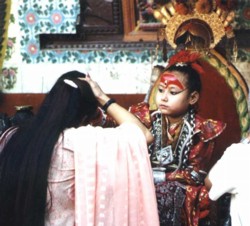
|
For of this you can be sure: No immoral, impure or greedy person - such a man is an idolater - has any inheritance in the kingdom of Christ and of God. (Ephesians 5: 5)[14]
But the Bible also makes it clear that possessions themselves are not sinful. Again it is Paul who tells us that, "... everything God created is good, and nothing is to be rejected if is it received with thanksgiving ..." (1 Timothy 4: 4). So the mere possession of material wealth is not in itself a sin. Materialism is a sin of the heart, which is why we are never to be judgmental over some other believer's wealth.
Real worship also is an act of the heart. David expresses it thus:
You do not delight in sacrifice, or I would bring it; you do not take pleasure in burnt offerings. The sacrifices of God are a broken spirit; a broken and contrite heart, O God, you will not despise. (Psalm 51: 16-17)
The Lord's displeasure with mere formal ritual is also asserted through Isaiah:
These people come near to me with their mouth and honour me with their lips, but their hearts are far from me. Their worship of me is made up only of rules taught by men. (Isaiah 29: 13)
Now for many of our Hindu neighbours, worship is a mere custom. Some may be quite honest and say they have no interest in dharma. They perform the ritual because that is what is expected of them. They do not want to cause offence. When one observes the shear quantity of ritual in the average Hindu's life it might come as a surprise to discover that pious Hindus, in fact, often have much the same attitude to worship as the Bible. They will condemn the ritual act of one who merely wants to impress his peers. The mere act, then, is meaningless. Real puja is that done from the heart, with pure motives.
The Bible has such an attitude to idolatry. The mere association with an idol is not condemned. Idol worship is condemned (see e.g. Romans 1: 18-23 and many other passages) but the mere association with an idol is not. How can this be? Because the idol itself is nothing but a material object, as Isaiah and others pointed out with such irony (Isaiah 44: 9-20; 46: 1-7). Paul agrees: "We know that an idol is nothing at all in the world ..." meaning that it is of no spiritual consequence (1 Corinthians 8: 4). This same point is made in the Old Testament in the astonishing story of Naaman (2 Kings 5). The Syrian general is brought to a saving relationship with the living God through his miraculous healing from leprosy and through his faithful obedience to Elisha's command. As he is about to take the prophet's leave he makes a startling request:
But may the Lord forgive your servant this one thing: When my master enters the temple of Rimmon to bow down and he is leaning on my arm and I bow down there also - when I bow down in the temple of Rimmon, may the Lord forgive your servant for this. (2 Kings 5: 18)
There is Naaman, in his newfound faith, anticipating a conflict. He sees a tension coming up on his return to Syria. He knows that he will have to enter the temple of Rimmon as usual at the king's side, and that the king will bow down as he always does and that he, Naaman, will also have to bow down as the decrepit king leans on him. But Elisha seems to have no hesitation or struggle to calmly reply, "Go in peace" (2 Kings 5: 19). How can Elisha say such a thing? Because, like Paul, he knows that the idol of Rimmon is nothing.
That is also the reason, as Paul explicitly states, that the believer in Christ can eat food sacrificed to an idol without compromising his faith (1 Corinthians 8: 4-6). But one might object: Doesn't Paul also say "the sacrifices of pagans are offered to demons..." (1 Corinthians 10: 20)? It seems to me that we must find the answer to this seeming paradox in the distinction between action and intention. The idol itself is not a demon. Neither does the Bible anywhere describe demons as 'attaching' themselves to, or possessing idols. What Paul is saying here is that, when a man really worships an idol (i.e. with true, heartfelt, intent) then he is worshipping demons. Naaman's action was not sinful because his heart was not in it. He had no more desire to worship Rimmon than he had previously had the desire to plunge into the muddy waters of the Jordan River. It was offensive to him. No problem, say Elisha and Paul, keep your heart pure.
So when the disciple of Jesus is approached to receive tika he can take it with a clear conscience because he knows that it will bring him neither blessing nor condemnation. He will pray for the opportunity (then or later) to explain his belief about such rituals but he won't cause unnecessary offence by refusing his relatives? good intentions, no matter how mistaken they are.
It is the same with prasad. In fact most Christians in Nepal, at least in the Kathmandu Valley, are already eating prasad on a regular basis (though they may not know it) as the Newar Butchers (Khadgi/Nay), who slaughter almost all of the meat consumed here, always slaughter animals in the course of a brief ritual sacrifice.[15] This makes the eating of their meat by their customers the taking of consecrated prasad.
So the attitude of the believer in Christ to the offer of meat sacrificed to an idol, at Dasain or any other occasion, should be one of thanksgiving.
... God created [it] to be received with thanksgiving by those who believe and who know the truth. For everything God created is good, and nothing is to be rejected if is it received with thanksgiving, because it is consecrated by the word of God and prayer. (1 Timothy 4: 3b-5)
Someone might make another objection: will not the receiving of tika or the consumption of prasad open the believer to an attack, or even possession, by a demon? I have tried to answer this objection before.[16] Suffice it to say here that no such doctrine is taught in the Bible. Everywhere in Scripture idolatry is condemned but nowhere does it say that the worship of (still less the association with) an idol is tantamount to an invitation to demons to enter or attack a person. The Old Testament tells us precious little about the activity of evil spirits, but the case of Job is instructive. We are told (pity poor Job who wasn't) that the Adversary attacked Job at the Lord's invitation (Job 1: 6-8). Job was "blameless and upright" (v. 1), not one who had worshipped idols. The New Testament has much more on the demonic but I am aware of no instance where the possessed individual is said to have had anything to do with idols. Of course, they might have done, but one would think that if the association were so important the New Testament writers would have mentioned it. Idolatry is roundly condemned but not the mere association with idols.[17]
The final objection by Christians to the receiving of tika is that it blurs the distinction between Christians and Hindus. Clearly Muslims feel the same way about it, otherwise they would not stop short at the wearing of vermilion. And here we have a key to understanding the Christian objection. The Muslim community in Nepal, as elsewhere, has a strong social, even ethnic, identity. To be a Mussalman is to belong to a certain community. Wearing vermilion would compromise their identity.
So when someone objects to the Christian wearing tika because it will be harder to know whether he is a Christian or not, they are saying that tika identifies the wearer as belonging to a social or ethnic group. The Old Testament believing community also had such an external symbol, in the rite of circumcision. But in the New Testament the Lord Jesus gives his disciples a radically new sign of their inclusion in the community of faith.
A new command I give you: Love one another. As I have loved you, so you must love one another. By this all men will know that you are my disciples, if you love one another. (John 13: 34-35)
As Francis Schaeffer reminded us, the mark of the Christian is not some external symbol (e.g. the wearing of a cross, or the non-wearing of tika) - it is love.[18] Whenever the church insists otherwise it is a corrupt church.
The giving and receiving of tika is a profoundly social issue. To receive tika from one's father or mother or brother or sister is to affirm that one still belongs to the family. To receive it from one's uncle or aunt is to affirm that one still belongs to the lineage. And that is exactly the emphasis of the New Testament. There is no Biblical basis for switching from one community to another on profession of faith in Christ. Rather, " ...each one should retain the place in life that the Lord assigned to him and to which God has called him" (1 Corinthians 7: 17).
God's command to "Honour your father and your mother, so that you may live long in the land the Lord your God is giving you" has never been abrogated (Exodus 20: 12). In the New Testament it is re-emphasized (Ephesians 6: 1-3). Again, God has put the believer in a social context that comes with certain demands. In this connection, Paul says, "Give everyone what you owe him: If you owe taxes, pay taxes; if revenue then revenue; if respect, then respect; if honour, then honour" (Romans 13: 7). In the Nepali context the giving of respect and honour is most clearly expressed in the giving and receiving of tika. So not only is the believing member of a Hindu family free to receive tika, on the basis of the Bible he is obligated to do so. Furthermore, he should give it to those who are his junior in the lineage. But some may find it just too difficult to give tika from an offering plate. Then they should prepare a different plate of paste themselves as, in fact, some Christ-bhakta friends of mine do. Their relatives do not object. It is the mark that shows filial affection and respect that they are eager to receive - they are not concerned about its origin.
But, someone might object, what about the believer with a tender conscience? There is a short answer and a long answer to this question. I will try to give both. Firstly, and simply, the believer must do only what he can do in faith (Romans 14: 23). But secondly, one must ask how do we help someone with a troubled conscience? One might feel guilty doing something that is perfectly all right, as Paul himself makes plain (Romans 14: 1 - 15: 13). Such a person is handicapped by his overly scrupulous conscience. One must treat such a person with sensitivity. But one should never let such a person impose his scruples on others. He needs to learn that he is being over-scrupulous and can learn freedom in place of his self-imposed rules, as Paul was instructing such believers in his letters (Romans 14 & 1 Corinthians 8-10). Moreover, there are those who are not scrupulous enough about what God has plainly revealed. The believer who treats his father and mother with contempt must have his conscience enlightened, as it has surely been seared. The believer who feels guilty about receiving tika, therefore, needs to be helped to see that he has freedom to do so. And the believer who feels no guilt at mistreating his elders by refusing tika must be helped to see his obligation under the law of love.
It may seem that giving a new believer the option to wear tika is to make the Christian life too easy. There are many who have paid a great price by making a stand at this point. But is this path really the easier one? The path of Legality, as Bunyan's Christian found out, may at first seem easier going, but it can never lead to salvation, only to bondage.[19] Making the refusal to wear tika the mark of the follower of Christ is the shortest route to a hypocritical, unregenerate church. Why? Because it is the easiest thing for a person to refuse tika if by doing so he will be assured of his favour with God. So the way of love, the insistence on inward marks of grace, is the harder way, not the easier way. The wearing of tika and the eating of food sacrificed to idols has long dominated discussion surrounding the Christian's potential participation in what, after all, is a very important family and lineage occasion. It is about time these issues were revisited and a heavy yoke lifted from the neck of the new believer. The church of Nepal cannot expect further blessing until it does so.
Notes
References